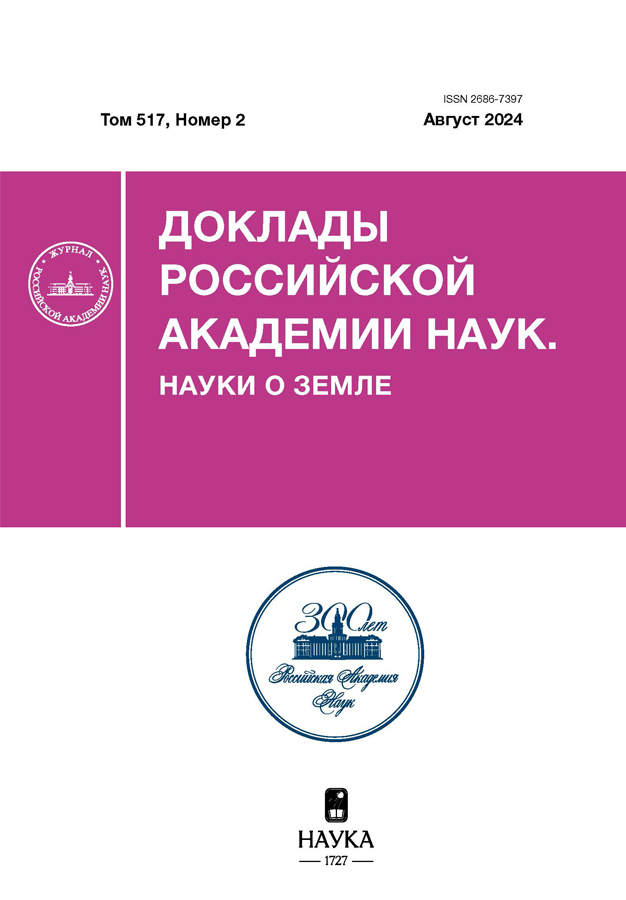New data on potential mobility of artificial radionuclides in bottom sediments of the Yenisei River
- Autores: Bolsunovsky A.Y.1, Borisov R.V.1, Dementyev D.V.1
-
Afiliações:
- Federal Research Center “Krasnoyarsk Science Center” Siberian Branch of the Russian Academy of Sciences
- Edição: Volume 517, Nº 2 (2024)
- Páginas: 237-244
- Seção: GEOCHEMISTRY
- ##submission.dateSubmitted##: 31.01.2025
- ##submission.datePublished##: 29.12.2024
- URL: https://snv63.ru/2686-7397/article/view/649980
- DOI: https://doi.org/10.31857/S2686739724080059
- ID: 649980
Citar
Texto integral
Resumo
The present study shows that after the shutdown of the nuclear reactor at the Mining-and-Chemical Combine (MCC) of Rosatom in 2010, artificial radionuclides (60Co, 137Cs, 152Eu, and 241Am) are still detected in the bottom sediments (BS) of the Yenisei River in the MCC affected area. The paper, for the first time, reports results of the study comparing potential mobility of artificial radionuclides in the surface and lower layers of the Yenisei BS long after the shutdown of the MCC nuclear reactor. The mobility of radionuclides was estimated using the well-known procedure of sequential extraction of BS. A new finding is that potential mobility of 60Co is higher in the lower (older) BS layers compared with the upper ones. Radionuclide 137Cs is strongly bound with mineral solids of BS (approaching 100%) regardless of the time factor. The new data showing that 241Am and 152Eu retain their high potential mobility in the BS over long periods and that 60Co potential mobility increases over time suggest potential bioavailability of these radionuclides in the Yenisei River ecosystem.
Texto integral
Sobre autores
A. Bolsunovsky
Federal Research Center “Krasnoyarsk Science Center” Siberian Branch of the Russian Academy of Sciences
Autor responsável pela correspondência
Email: radecol@ibp.ru
Institute of Biophysics
Rússia, KrasnoyarskR. Borisov
Federal Research Center “Krasnoyarsk Science Center” Siberian Branch of the Russian Academy of Sciences
Email: radecol@ibp.ru
Institute of Biophysics, Institute of Chemistry and Chemical Technology
Rússia, KrasnoyarskD. Dementyev
Federal Research Center “Krasnoyarsk Science Center” Siberian Branch of the Russian Academy of Sciences
Email: radecol@ibp.ru
Institute of Biophysics
Rússia, KrasnoyarskBibliografia
- Vakulovsky S. M., Kryshev I. I., Nikitin A. I., Savit sky Y. V., Malyshev S. U., Tertyshnik E. G. Radioactive contamination of the Yenisei River // J. Environ. Radioactivity. 1995. V. 29. P. 225–236.
- Болсуновский А. Я., Ермаков А. И., Мясоедов Б. Ф., Новиков А. П., Соболев А. И. Новые данные по содержанию трансурановых элементов в донных отложениях реки Енисей // ДАН. 2002. Т. 387. № 2. С. 233–236.
- Сухоруков Ф. В., Дегерменджи А. Г., Белолипецкий В. М., Болсуновский А. Я., Ковалев С. И., Косолапова Л. Г., Мельгунов М. С., Рапута В. Ф. Закономерности распределения и миграции радионуклидов в долине реки Енисей. Новосибирск: Изд-во СО РАН. Филиал “Гео”, 2004. 286 с.
- Linnik V. G., Brown J. E., Dowdall M., Potapov V. N., Nosov A. V., Surkov V. V., Sokolov A. V., Wright S. M., Borghuis S. Patterns and inventories of radioactive contamination of island sites of the Yenisey River, Russia // J. Environ. Radioactivity. 2006. V. 87. P. 188–208.
- Bolsunovsky A. Artificial radionuclides in sediment of the Yenisei River // Chemistry and Ecology. 2010. 26 (6). P. 401–409.
- Semizhon T., Röllin S., Spasova,Y., Klemt E. Transport and distribution of artificial gamma-emitting radio nuclides in the River Yenisei and its sediment // J. Environ. Radioactivity. 2010. V. 101, P. 385-402.
- Болсуновский А. Я., Дементьев Д. В., Вахрушев В. И. Масштабный перенос техногенных радионуклидов по течению реки Енисей во время экстремального паводка 1966 года // ДАН. Науки о земле. 2021. Т. 498. № 2. С. 189–194.
- Отчет по экологической безопасности ГХК за 2021 год. Железногорск. 48 с. https://sibghk.ru/images/pdf/eco/ghk_ecorep_2021.pdf
- Bolsunovsky A., Dementyev D., Trofimova E. Biomo nitoring of radioactive contamination of the Yenisei River using aquatic plants // J. Environ. Radioactivity. 2020. V. 211. Art. № 106100.
- Tessier A., Campbell P. G. C., Bisson M. Sequential extraction procedure for the speciation of particulate trace metals // Analytical Chemistry. 1979. V. 51 (7). P. 844–851.
- Salbu B., Lind O. C., Skipperud L. Radionuclide speciation and its relevance in environmental impact assessments // J. Environ. Radioactivity. 2004. V. 74. Issues 1–3. P. 233–242.
- Hlavay J., Prohaska T., Weisz M., Wenzel W. W., Stingeder G. J. Determination of trace elements bound to soil and sediment fractions (IUPAC Technical Report) // Pure and Applied Chemistry. 2004. V. 76. No 2. P. 415–442. https://doi.org/10.1351/pac200476020415
- Bacon J. R., Davidson C. M. Is there a future for sequential chemical extraction? // Analyst. 2008. V. 133. P. 25–46. doi: 10.1039/b711896a.
- Skipperud L., Brown J., Fifield L. K., Oughton D. H., Salbu B. Association of plutonium with sediments from the Ob and Yenisey rivers and estuaries // J. Environ. Radioactivity. 2009. V. 100. P. 290–300.
- Болсуновский А. Я., Дегерменджи А. Г. Сравнение миграционной способности урана и техногенных радионуклидов в донных отложениях реки Енисей // ДАН. 2013. Т. 448. № 5. С. 571–575.
- Павлоцкая Ф. И., Горяченкова Т. А., Казинская И. Е., Новиков А. П., Кузнецов Ю. В., Легин В. К., Струков В. Н., Шишкунова Л. В., Мясоедов Б. Ф. Формы нахождения и миграционное поведение Pu и Am в пойменных почвах и донных отложениях реки Енисей // Радиохимия. 2003. Т. 45. № 5. С. 471–478.
- Вахрушев В. И., Болсуновский А. Я., Дементьев Д. В. Использование радиоизотопных методов для хронологии поступления Cs-137 в донные отложения реки Енисей // Вестник Удмуртского университета. Серия Биология. Науки о Земле. 2023. Т. 33. Вып. 2. С. 178–190.
- Manakhov D. V., Emelyanov A. M., Karpukhin M. M., Lipatov D. N., Agapkina G. I., Mamikhin S. V. Compa rison of methods for assessment of radionuclide specia tion in soils // Biology Bulletin. 2019. V. 46. P. 1671–1678.
- Bolsunovsky A., Melgunov M., Chuguevskii A., Lind O. C., Salbu B. Unique diversity of radioactive particles found in the Yenisei River floodplain // Scientific Reports. 2017. 7. Art. № 11132. Р. 1–10.
Arquivos suplementares











